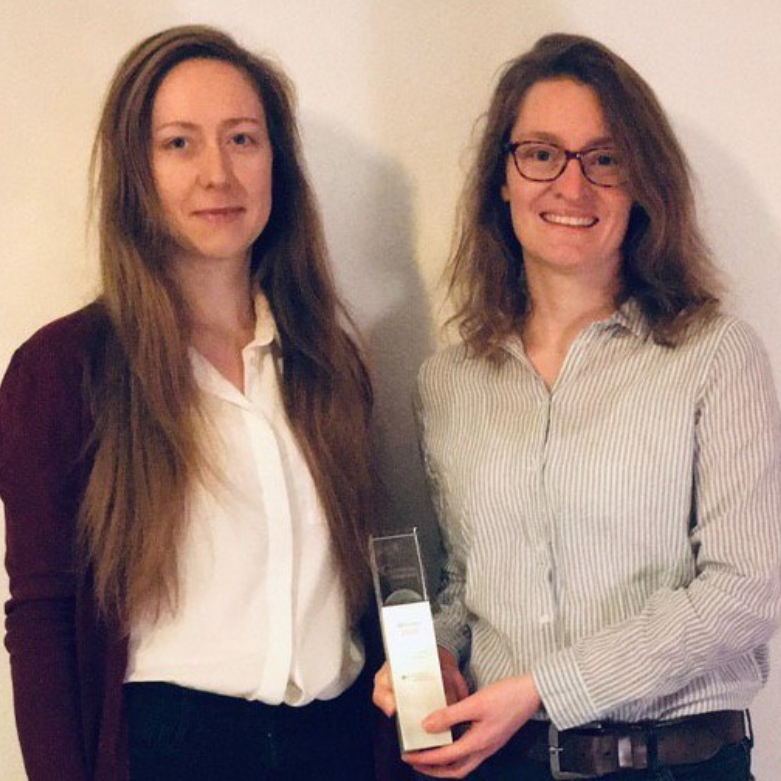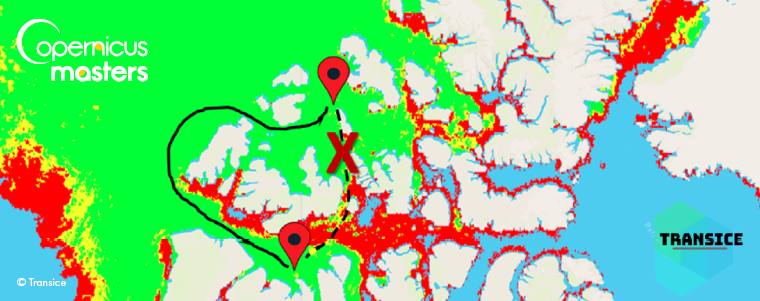Global warming is one of the major issues today’s society is facing. Rising temperatures affect our planet’s health and well-being, and the environment, but we also register extensive impacts to human-made infrastructure. One of the most severely affected regions is the Arctic. Today, around five million people live in these remote areas and Arctic tourism is more popular than ever before. Mobility in these regions is thus of major importance. Indigenous communities embark on hunting trips across the frozen oceans, tourists long for snowmobile adventures, and scientists need to travel long distances for sampling on expeditions.
Furthermore, not all Arctic communities are self-sufficient and thus also heavily rely on imported goods such as building materials, fuel, or even basic necessities for everyday life. Such goods are often imported via road transport as the cost of air freight is too high. However, road networks and such human-made infrastructure are rather scarce in these latitudes.
Navigation across ice roads and frozen lakes and oceans is, therefore, one of the most important opportunities for cross-country travel.
While indigenous communities had many generations to adapt to the harsh and cold environment and to optimise their hunting habits in this extreme setting, the current acceleration of climate warming introduces enormous difficulties for them. The period in which ice roads, which are essential for transport, are trafficable has considerably decreased from 200 days per year to only 100 days per year in the last 40 years alone. This has previously caused import delays and supply shortages for the remote communities.
The number of reports of dangerous accidents during adventure tours in the Arctic, for example, snowmobile tours in Svalbard, as well as their severity has also increased considerably. Unfortunately, tour providers are not always aware of the currently dangerous and rapidly changing ice conditions and nonetheless embark on travels with their customers. Sometimes with fatal consequences.
Alexandra Zuhr, a polar climate scientist, and Tabea Rettelbach, a remote sensing specialist, have therefore come up with a possible solution to considerably facilitate travel across the Arctic ice: their mobile and web application TransIce provides an easy-to-use framework for off-road navigation across frozen waters in the Arctic.
Having experienced difficult navigation in these polar regions themselves, the researchers know the value of reliable and up-to-date information for safe travel in hazardous conditions. Alexandra has even witnessed first-hand the deaths of people who have fallen through excessively thin ice. It’s therefore a very personal issue for her, and she is very driven to contribute to the communities and get TransIce Nav out there to help mitigate accidents like these in the future.
TransIce Nav as a mobile application is heavily inspired by standard apps for navigation such as Google Maps. The pivotal advantage of TransIce Nav, however, is the focus on off-road (or rather on-ice) navigation that takes into account any environmental conditions such as sea ice thickness and extent, the quality of the ice, and the surface temperature. This considerably facilitates any navigation in the field, as the app will guide the user through the ice where it is safest, naturally taking into account the shortest route possible. With the accompanying web application, TransIce also offers the possibility for extensive and comprehensive route planning ahead of a trip and additionally provides an integrated warning system. This enables the user to share their GPS location at any time so that the TransIce app can warn them, should they come too close to critical areas where the ice is excessively thin.
The foundation of the service is built upon Sentinel-1 and Sentinel-2 data to determine ice extent and thickness and integrates forecasts from the Copernicus Marine Service to provide predictions on the future conditions up to five days in advance. The tool benefits greatly from the free and straightforward availability of the Copernicus data and especially the frequent revisits of the satellites in the polar regions. The integration of the datasets from different sources and the automated prediction of environmental conditions is heavily facilitated by the use of artificial intelligence and the employment of deep neural networks. In this era of big data in Earth observation, such automation is indispensable and invaluable.
The original idea for TransIce was born at a hackathon at the German Aerospace Center in Berlin in November 2019. In only 24 hours, Alexandra and Tabea, then still working with two further Computer Science students from Hanover, developed the idea along with a first prototype. At the hackathon’s project pitches, the four researchers even won one of the first prizes with their TransIce prototype. Back then, they did not in the slightest anticipate that, one year later, they would be invited to the Copernicus Masters Space Awards as a finalist. Yet, after a few months of refining ideas, researching the market, and pitching their idea to several juries, there they were, not in Bonn (where the awards were originally planned to be held in 2020), but in front of their computers, to watch the awards ceremony and find out that they have been announced as the winners of the ‘Transport’ challenge hosted by the German Ministry of Transport and Digital Infrastructure.
Today, a few months after this honourable award, both Alexandra and Tabea are still finalising their dissertations (which thematically go hand in hand with their ambitions for TransIce) and manage TransIce’s first steps into the world of startups on the side. Coming from an academic background, they are currently following up on further business training and expanding their network. The development of the advanced algorithms is also underway. As the application will play an integral part in improving secure navigation in remote but rapidly developing regions and is anticipated to help save human lives, the predictions for route suggestions need to be as reliable as possible and accuracy cannot be compromised for a fast release. Nevertheless, the viable product is underway. The founders say that, even though it’s a rather distressing time to work in climate and environmental sciences, it is also incredibly interesting and offers plenty of potential to get involved with social entrepreneurship. They are excited to further work on improving their ideas, their algorithms and their business to soon be able to improve the lives and livelihoods of communities living in the Far North.
 Authors’ bio:
Authors’ bio:
Tabea Rettelbach and Alexandra Zuhr are both doctoral researchers at the Alfred Wegener Institute for Polar and Marine Research in Potsdam, Germany. Both have a background in Earth and environmental science and have experienced the extreme conditions of the Arctic on multiple expeditions themselves. Together they are the founders of TransIce.





Comments are closed.